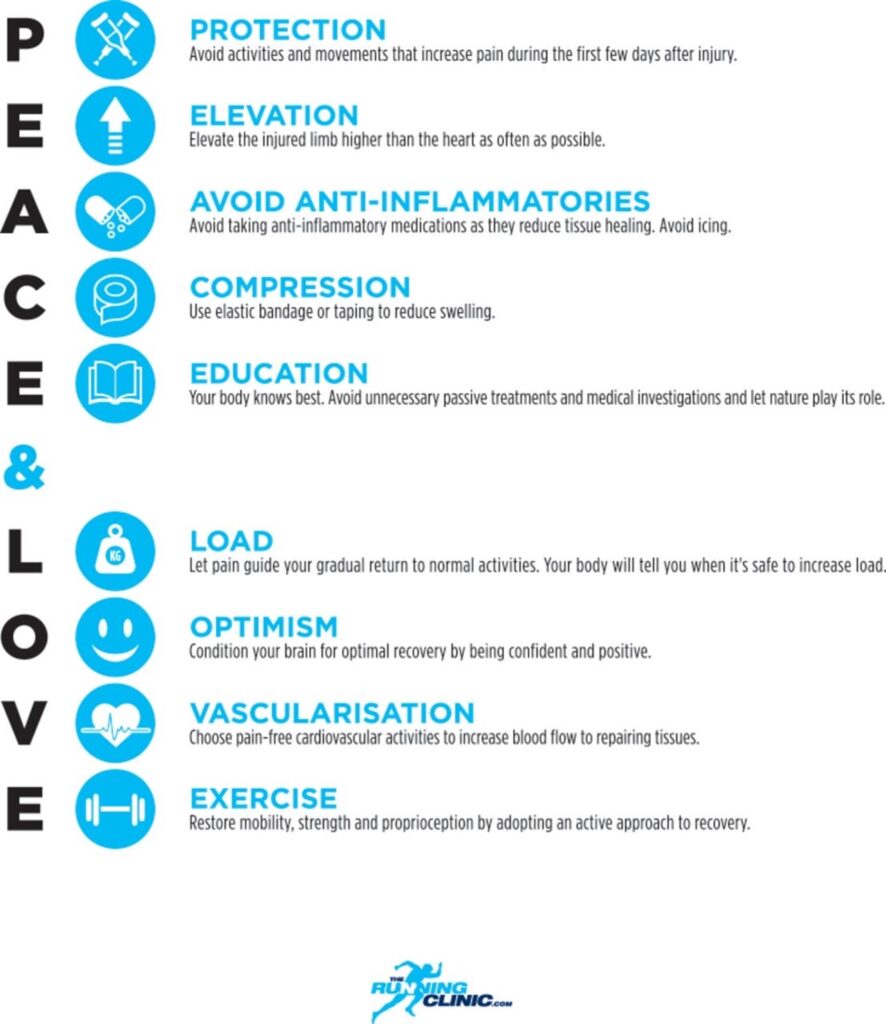All you need is PEACE and LOVE after a soft tissue injury according to Blaine Dubois and Jean-Francois Esculier, two physiotherapists who have researched how to achieve optimal recovery after a soft tissue injury. The two have written an article that uses two new acronyms, PEACE and LOVE to help make it easy to remember.
If you have ever sprained an ankle, I am sure you have been told once or twice to RICE, PRICE, or POLICE when it comes to managing your injury. The two claim the previous acronyms leave out the later phases of tissue healing such as, sub-acute and chronic phases. They decided to split the acronyms into two parts, PEACE addresses the acute phase, while LOVE addresses the sub-acute and chronic phases of tissue healing (1).

It’s important to understand the phases of tissue healing and why it is necessary to get the best recovery. There are 4 phases of tissue healing: (1)

- Bleeding Phase (Acute)
- Starts 4-6 hours after injury
- Amount of bleeding depends on injury type and what soft tissue(s) were injured
- Ligaments have a poor blood supply and bleed less, this is why they take longer to heal
- Muscles have a good blood supply causing them to bleed longer causing larger bruising
- Rest is important to allow the bleeding to clot
- Inflammatory Phase (Sub- Acute)
- Starts 1-2 hours after an injury and can last for 1-2 weeks
- Inflammation and bleeding occur under the skin which is necessary for the body to start healing itself and move on to the next phase
- Towards the end of this phase the blood clot gets smaller and new fibrous tissue forms
- Follow No HARM (no heat, no alcohol, no running or strenuous exercise, and no massage) these will all increase bleeding and swelling
- Avoid anti-inflammatory medications for the first few days try taking paracetamol instead for pain relief
- Fibroblastic Repair (Chronic Phase)
- Starts as soons as 2 weeks to 6 weeks
- The body starts making collagen fibres to lay down across the injured tissue to form a scar
- Likely to have less pain
- High risk of re-injury due to weakness of newly formed scar tissue
- Remodelling Phase (Regeneration)
- Starts as early as 2-3 weeks and last up to months or years
- The body continues organise the fibres and lay more layers, this increases the strength of the tissues
- Resistive exercises increase the load on the tissues which helps to bring the fibres together
A few key points to consider when caring for a soft tissue injury (1):
- In order for soft tissues to heal, the inflammatory phase needs to occur
- Anti- inflammatory medications and the use of ice early on are not advised due to slowing down the inflammatory process
- Compression helps reduce excess swelling in the early stages
- By reducing stress, having positive beliefs and emotions about your injury can provide a better functional outcome
By reducing stress, having positive beliefs and emotions about your injury can provide a better functional outcome - Pain free cardiovascular activities and exercises in the chronic phase help increase blood flow, improve movement, strength, and proprioception
At Gold Coast Hand Therapy we have highly qualified Physiotherapists and Occupational Therapists that provide appropriate assessments and treatment plans for hand and upper limb conditions. This might include further testing such x-rays, ultrasound, MRI, or CT scan to determine severity of injury.
We fabricate custom made splints to immobilise your injury if required. We also provide treatment to assist with reducing pain and oedema, management of wounds and scars and exercise programs to help increase movement, strength, and stability.
Written by Kelsy Weavil (Physiotherapist)
References:
- Dubois, Blaise, and Jean-Francois Esculier. “Soft-Tissue Injuries Simply Need Peace and Love.” British Journal of Sports Medicine, vol. 54, no. 2, 2019, pp. 72–73., https://doi.org/10.1136/bjsports-2019-101253.
- Phases of tissue healing.The Complete Guide to Sports Injuries, published by A&C Black 2011 SportEX medicine 2012;51(January):22-27.
“Soft Tissue Healing.” Physiopedia, https://www.physio-pedia.com/Soft_Tissue_Healing.